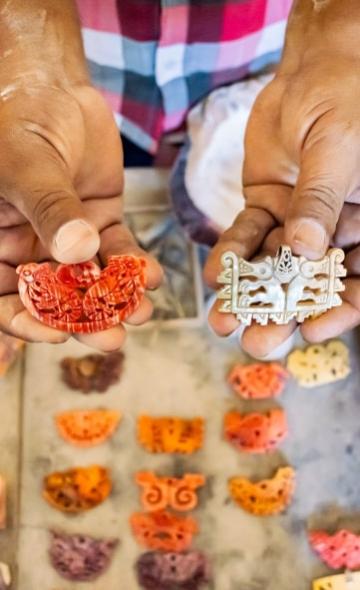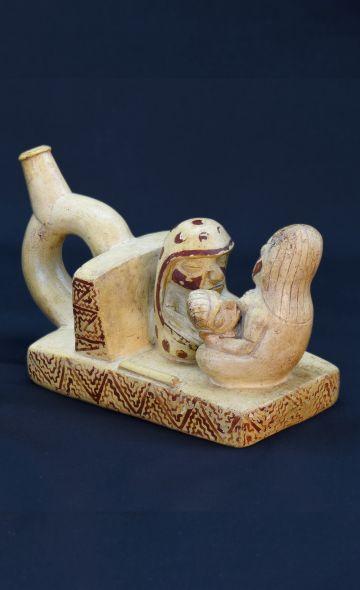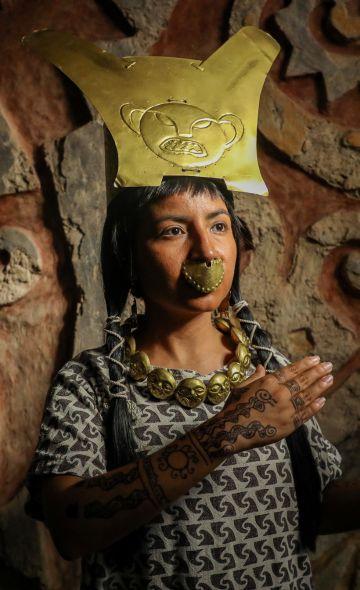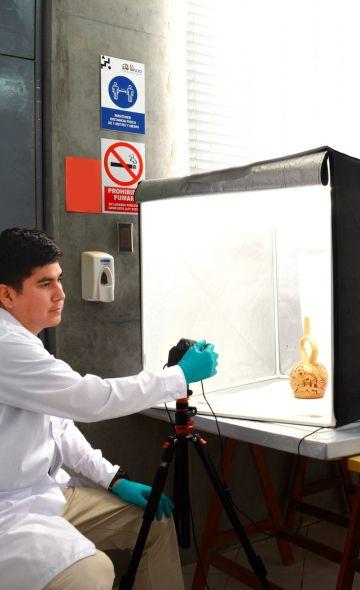- Visitors
- Researchers
- Students
- Community
- Information for the tourist
- Hours and fees
- How to get?
- Visitor Regulations
- Virtual tours
- Classic route
- Mystical route
- Specialized route
- Site museum
- Know the town
- Cultural Spaces
- Cao Museum
- Huaca Cao Viejo
- Huaca Prieta
- Huaca Cortada
- Ceremonial Well
- Walls
- Play at home
- Puzzle
- Trivia
- Memorize
- Crosswords
- Alphabet soup
- Crafts
- Pac-Man Moche
- Workshops and Inventory
- Micro-workshops
- Collections inventory
- News
- Researchers
- Artisanal Work Series: The "Spondylus", treasure of the past, inspiration of the present
News
CategoriesSelect the category you want to see:
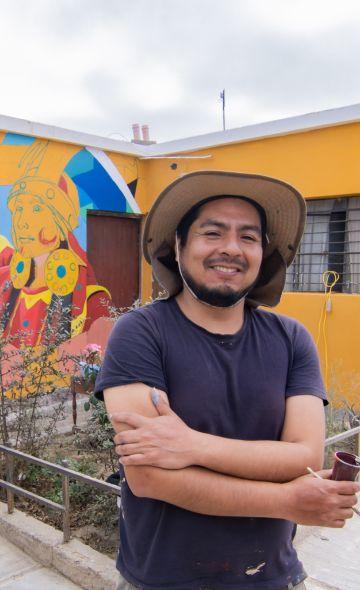
Magdalena de Cao to Once Again Host an International Mural Art Gathering ...
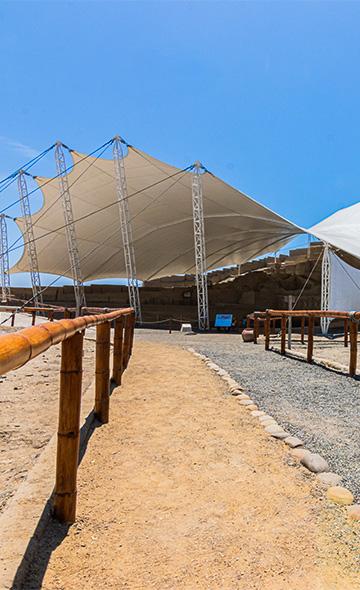
Explore El Brujo Through Virtual Tours: Culture and History at a Click ...
To receive new news.
By: Katerine Albornoz
By Katerine Albornoz
With the arrival of the Spaniards in the New World, a new opportunity opened up to explore the past through their written records. One of these documents is the manuscript of Francisco de Ávila, the extirpator of idolatries, who highlights the relevance of mullu, also known as Spondylus. This importance is reflected in the following paragraph:
"The Inga appreciated Pariacaca even more and gave him fifty yanas. "Father Macahuisa", he said to the victorious huaca, "What shall I give you? Ask for everything you want. I will not be greedy." The other replied: "I do not want anything, except that you become a huacsa and celebrate my worship as do our children of Yauyos". The Inga accepted but, as he feared him very much, he wanted to offer him everything that he could so that he would not annihilate him, too. So, he ordered food to be offered to him, but Macahuisa told him: "I do not usually eat these things", and asked him to bring him mullu" (Taylor, 2008, p.103)
The presence of mullu in the above text raises several questions that invite reflection: What is our current knowledge about this marine organism? What was the importance attributed by our ancestors to this mollusk and since when? Does it have some kind of significance or relevance in the contemporary context? These topics will be explored in this note.
Spondylus: Learning about its characteristics
Spondylus, a bivalve mollusk of the Spondylidae family, inhabits warm waters in several regions of the world. In total, there are 72 known species of Spondylus. In the American continent, three have been recorded: one in the Atlantic and two in the Pacific oceans. In the latter, the best-known species, Spondylus Princeps and Spondylus Calcifer, are found (Cota, 2011; López C, 2005).
The Spondylus Princeps stands out by its intense red color, although occasionally specimens can be found with shades ranging from white to orange, red and purple. Also, it has a series of spines that protrude from its shell. Its habitat extends from Panama to northwestern Peru, specifically in Tumbes, where it is usually found attached to small rocks and corals, or resides on the sandy bottom at depths ranging from 18 to 50 meters below the surface (Cota, 2011; López C, 2005; Pillsbury, 1996).
A fundamental aspect is that this mollusk has been present in pre-Hispanic societies, both in the iconographic representations of the oldest archaeological records, such as the Tello Obelisk, which dates approximately from between 1200 B.C. and 800 B.C. Moreover, evidence of its use as a worked object has been found on the central coast, dating from between 950 B.C. and 650 B.C. (Paulsen, 1974; Taylor, 2008; Wester La Torre, 2016).
As for Spondylus Calcifer, it is commonly recognized as "Pacific oyster" and has a color that varies between red and purple. Its habitat ranges from the Gulf of California in Mexico down to Punta Pariñas, located in the department of Piura, Peru. This mollusk is between sea level at low tide and sea level at high tide, the intertidal zone, adhering to rocky bottoms between 5 and 10 meters deep (López C, 2005).
A look at our past: The presence of Spondylus
As we have previously remarked, both species of Spondylus are mainly found in the waters of Ecuador and, to a lesser extent, in the waters of northern Peru. However, this circumstance was not an obstacle for our ancestors to have access to this mollusk in particular.
Archaeological analyses offer both a spatial and temporal perspective on the presence of Spondylus in the ancient Peruvian territory, from the Middle Formative period (1,200 - 800 B.C.) to the Late Horizon (1400 – 1532 A.D.). This phenomenon extends throughout various geographical areas of Peru, which include both coastal and highland regions (Gorriti, 2000; A. M. Hocquenghem, 1993; Paulsen, 1974; Quinatoa, 2021).
.jpg)
These discoveries posed a fundamental question: What is the relevance of a material originating from warm water marine currents so that it may be present on the Peruvian coast and sierra?
In order to address these questions, based on existing research, we will begin by delving into how this mollusk is obtained and its physical characteristics as a starting point to understand its relevance. Then, we will explore its possible significance according to the contexts in which it has been found.
The way of obtaining Spondylus varies depending on the species, which involves different levels of effort. For example, in the case of Spondylus Princeps, an individual must dive to depths ranging from 18 to 50 meters to collect specimens. This activity, therefore, requires the dedication of specialized people, who have developed the necessary capacity to resist the water pressure during these dives. Moreover, divers carrying out this task must be equipped with cutting instruments to separate the mollusks from the rocks, which could make it difficult to remove them without damaging them (see image 2) (A. Hocquenghem, 2010; Marcos, 1980; Wester La Torre, 2016.
With respect to the physical and anatomical characteristics of Spondylus in its natural habitat, it is fixed to the rock, we can see that the left valve exhibits a series of thorns that suggest a protective function, aside from serving as a receptor for microorganisms that contain toxins dangerous for humans. This implies that Spondylus may pose a risk at certain periods. Aside from that, the right valve naturally secretes an adhesive substance that facilitates its attachment to the rock surface (Quinatoa, 2021).
As has been pointed out, from its acquisition and extraction to its transport, both by sea and by land, owning this material involves various costs, such as economic ones, which makes obtaining it a privilege. Also, if we take into account the physical and anatomical particularities of Spondylus, these give it an exceptional quality, highlighting it as an object of great importance.
What evidence related to Spondylus has been found?
The Spondylus has been portrayed in various forms of material expression. Among the first evidence of its representation is the lithic sculptural piece called the "Bearer of the Shells" or "The Smiling God", discovered in the sunken circular plaza (see figure 3), as well as in many pieces of pottery (see figure 4) and in visual representations. Its presence is also featured in figurines carved in Spondylus, which were part of the Qhapaq-Qocha ceremony during the Inca period (1400 -1532 A.D.) (Faulbaum, 2011).
1.jpg)
As we can see, Spondylus has been a prominent element in significant events over time. There is evidence that it was used as an offering both in funeral ceremonies and in the construction of ceremonial structures or workshops on the north coast (Franco, 2008; Gorriti, 2000; López C, 2005; Wester La Torre, 2018).
This constant association of Spondylus with contexts of importance carries with it a significant symbolic charge. According to Eliade (1979), shells have a symbolism related to water, which in turn is linked to femininity. Fertility, a distinctive aspect of femininity, is of great importance in the Andean worldview, where the availability of fertile land for agriculture was crucial for the survival of the community (see image 5).
.jpg)
Moreover, the presence of the mollusk in its various forms, either in its natural state or as accessories such as figurines, necklaces, pectorals, bracelets or amulets in ritual or funerary contexts, can represent spiritual rebirth and facilitate the process of physical birth. This allows us to understand more deeply the reason for its appearance in certain contexts and to envisage a plausible explanation.
As additional information that supports the significant influence of Spondylus in our history, it is relevant to highlight the existence of workshops specialized in its processing, documented on the North Coast (A.-M. Hocquenghem & Peña Ruiz, 1994; Vílchez, 2013). These findings, together with the distinctive characteristics of Spondylus and ethnohistorical references, underscore its transcendence for pre-Hispanic societies in the economic, political, and religious ambits.
.jpg)
Back to the present: Where did Spondylus go?
With the passage of time, a gradual decrease in the relevance attributed to this material has been observed, accompanied by the progressive loss of specialized knowledge that had given rise to the establishment of workshops focused on the manufacture of jewelry, artistic figures and other ornamental objects. Nowadays, the presence of Spondylus is usually linked mainly to decorative purposes, which is due to its bright colors and its distinctive morphology, characterized by the presence of thorns.
In order to delve into the activity present today, we got in touch with Mr. José Riquelme, an artisan dedicated to work on Spondylus.
Conversation with the artisan
.jpg)
KA: How did your journey into artisanal work begin?
JR: "At the age of 10, I started carving wood by helping a neighbor who made chests and trunks. I learned by watching him and using tools like chisels to shape the wood. Later, I arrived in Pacasmayo, where I discovered stonework, which I also learned. And during our walks through the pampas of San Pedro de Lloc, I would find fragments of Spondylus on the ground, or chaquira beads, and I was intrigued by their potential for the creation of replicas. That is how I became interested in Spondylus. Over the years, I learned on my own how to work with this material, from shaping it to polishing and sanding it. It requires a certain care and dedication."
KA: What topics inspire you to create in your work with Spondylus?
JR: "I am especially inspired by the history of the Moche culture, which is characteristic of our northern region. Their figures and representations, such as birds, I consider to be valuable information about their culture and are a constant source of inspiration for me."
KA: Where does the Spondylus that you use in your artwork come from?
JR: "Spondylus is a bivalve mollusk found in warm waters, in Piura and beyond. However, for my artistic work, not just any Spondylus is adequate. I use the two variants from the Pacific: Calcifer and Princeps. When selecting the material, I look for those specimens whose surface is intact and in good condition. And to obtain them, I mainly travel north, to the Tumbes area, to select and obtain the necessary Spondylus."
Final Thoughts
As we have observed, our cultural heritage exhibits a great accumulation of knowledge, techniques and resources according to the characteristics inherent to our territory, and which could therefore be used in our present time. A characteristic of artisanal work in its various forms is the skill and expertise that the artisan must achieve to know his geographical environment, the properties of the materials that he uses and the techniques used, among other aspects. Currently, we look with a sense of respect and appreciation at craftsmanship, and we invite you to adopt a different perspective that includes a desire to explore the mysteries that lie in the background of each work. It is crucial to recognize that a sense of wonder is the starting point toward a deeper understanding of our cultural history.
Bibliography
Cota, G. (2011). Reproduction and growth of Spondylus Calcifer (Carpenter, 1857) in the central-western area of the Gulf of California (Agua verde, B.C.S.) [Thesis]. National Polytechnic Institute. Interdisciplinary Center for Marine Sciences.
Eliade, M. (1952). Images and Symbols (First). Arcadia.
Franco, R. (2008). The Lady of Cao. The Lords of the Kingdoms of the Moon, 280–297.
Gorriti, M. (2000). Marine mollusks: Spondylu, Strombus and Conus. Their significance in Andean societies. Bulletin of the Museum of Archaeology and Anthropology, 10–21.
Hocquenghem, A. (2010). The Spondylus Princeps and the Bronze Age in the Central Andes: The routes of exchange in the production of ornamental and votive prestige goods of ancient America (First). Syllaba Press.
Hocquenghem, A. M. (1993). Routes of entry of the mullu in the far north of Peru. Bulletin - Institut Français d'Études Andines, 22(3), 701–719. https://doi.org/10.3406/bifea.1993.1134
Hocquenghem, A.-M., & Peña Ruiz, M. (1994). The carving of the malacological material in Tumbes. Bulletin de l'Institut Français d'Études Andines, 23(2), 209–229. https://doi.org/10.3406/bifea.1994.1148
López C, F. (2005). Spondylus in pre-Hispanic Peru. Its religious and economic significance. Journal of Social Sciences and Humanities Studies, 33–42.
Marcos, J. (1980). Long-distance exchange in America: The case of Spondylus. Bulletin of American Anthropology, 1, 124–129.
Murra, J. (n.d.). The traffic of mullu on the Pacific coast. Economic and Political Formations of the Andean World (First, pp. 225–267). Institute of Peruvian Studies.
Paulsen, A. C. (1974). Society for American Archaeology. The Thorny Oyster and the Voice of God: Spondylus and Strombus in American Antiquity, 39(4), 597–607.
Pillsbury, J. (1996). The Thorny Oyster and the Origins of Empire: Implications of Recently Uncovered Spondylus Imagery from Chan Chan, Perú. Latin American Antiquity, 7(4), 313–340.
Quinatoa, E. (2021). The spondylus shell or "mullu", its importance for the ancestral peoples of America and its current situation. Bulletin of the National Academy of History, XCIX, 327–406.
Taylor, G. (2008). Rites and traditions of Huarochirí. French Institute of Andean Studies.
Vargas, P. (2005). Analysis of the graphic signs of the Tello Obelisk of Chavín de Huántar: A structural and linguistic proposal [Thesis]. Universidad Nacional Mayor de San Marcos.
Vílchez, C. (2013). The Spondylus workshop of Cabeza de Vaca. Workbooks of Qhapaq Ñan, 1(1), 116–133. www.cultura.gob.pe
Wester La Torre, C. (2016). The personage of the Spondylus of Chornancap, Lambayeque culture: from the sea to the grave. Quingnam, 2, 53–83.
Wester La Torre, C. (2018). Elite personages in Chornancap: a new vision of the Lambayeque Culture (First edition).
Researchers , outstanding news


